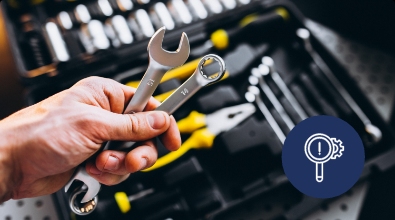

Dehumidifier Tips: How to get the most out of a dehumidifier?
Dive deep into our comprehensive insights of dehumidifier tips and leverage our expertise into optimizing your indoor environment and prevail optimal humidity levels at all times.
Introduction.
After buying a dehumidifier, we must understand its operation and some essential tips and tricks. This blog will empower you to learn tips to get the most out of your dehumidifier machine.
This comprehensive guide will help you, a first-time or existing owner, optimize your dehumidification system's performance. Humidity dryers are needed in every house today. We should get the maximum benefit from it to justify the costly purchase of the moisture remover.
Proper operation and maintenance also will increase the device's lifespan and reduce energy bills.
A house's most high humidity-prone areas are basements, bathrooms, kitchens, and... closets. Each of these spaces requires specific attention to ensure adequate moisture control. We will discuss addressing these unique challenges and provide additional tips tailored to particular areas.
Choosing the right industrial dehumidifier is the first step toward efficient moisture management. We will guide you through the considerations in selecting a dehumidifier, including room size, capacity, and energy efficiency.
Proper room dehumidifier placement is equally important to ensure optimal performance, and we will provide expert advice on finding the ideal location within your living space.
Setting the correct humidity level is crucial for effectively operating your commercial dehumidifier. We will delve into the recommended humidity range and explain how to use the built-in hygrometer or separate humidity gauges to achieve the desired results.
Regular maintenance and cleaning are essential to keep your dehumidifier operating efficiently and prolong its lifespan. We will outline the necessary maintenance tasks and frequency to ensure peak performance.
Adequate airflow and circulation contribute to optimal moisture removal and overall quality improvement. We will provide tips on maximizing ventilation while running the dehumidifier and utilizing other appliances. Furthermore, we will discuss the significance of proper ventilation in conjunction with your dehumidifier.
Energy efficiency is another crucial aspect to consider. We will highlight ways to minimize energy consumption without compromising the dehumidifier's performance.
From choosing energy-efficient models to employing innovative usage practices, you can effectively reduce costs while maintaining a comfortable and moisture-free living environment.
Finally, we will offer additional tips for specific areas of your home or industry. Each site presents unique challenges and requires strategies to combat moisture issues effectively.
Read more
Tip 1: Choosing the Right Dehumidifier.
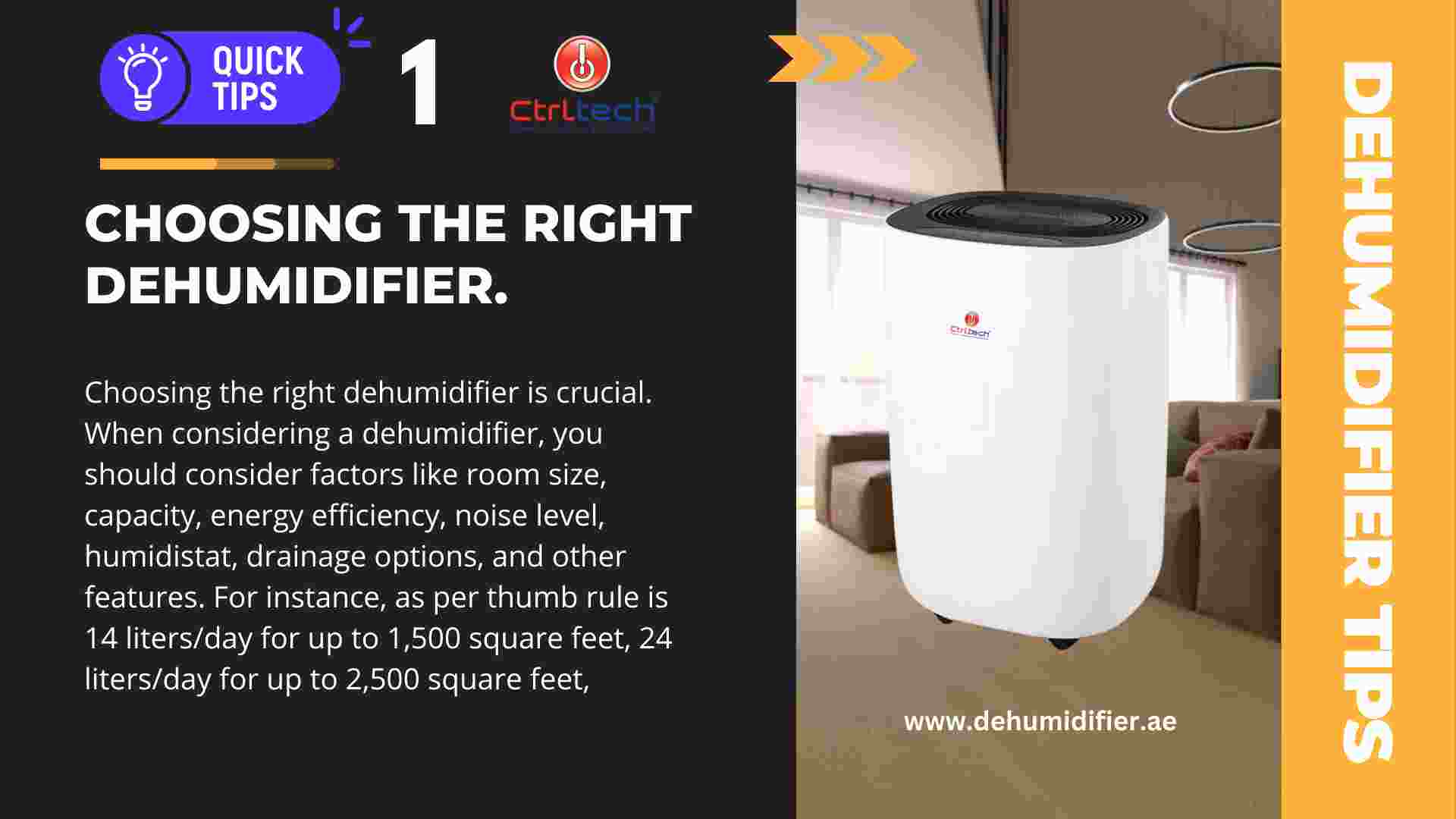
Choosing the right dehumidifier is crucial for efficient and effective moisture control in your living space. Consider the following factors when selecting a dehumidifier that suits your needs:
Room Size and Capacity: Take the room dimensions where you want to install the dehumidification system. Air dehumidifiers come in different capacities, typically measured in pints of moisture removed daily.
As per the general thumb rule, a 14 liter/day dehumidifier is suitable for rooms up to 1,500 square feet. A 24 liters/day dehumidifier can handle up to 2,500 square feet of medium-sized areas.
For larger spaces, such as basements or whole-house dehumidification, consider models with higher capacities, such as 33 or 43 liters per day.
..
Humidity Levels: We need the room's current humidity level for capacity calculation. Measure it using a hygrometer.
If the space's moisture level is high, you might need a high-capacity unit. To accommodate the effect of humidity fluctuation throughout the year, select a portable dehumidifier with a humidistat to adjust humidity settings.
Drainage Options: Consider the drainage options available with the dehumidifier. Most models offer two options: manual emptying or continuous drainage. Manual emptying requires you to empty the water tank when it fills up regularly.
You can connect the unit to a hosepipe to divert condensate water directly to the drain. Continuous drainage is convenient, especially if you plan to use the dehumidifier in a basement or other areas where emptying the tank frequently may be challenging.
Energy Efficiency: Energy Star-certified models are designed to consume less energy while providing effective moisture control.
Noise Level: Consider the unit's noise level, especially if you plan to use it in living areas or bedrooms. For industrial dehumidifiers, operation sound only matters a little. Look for models that feature low-noise operation or a quiet mode.
Reading customer reviews and checking the decibel ratings provided by manufacturers can help you choose a dehumidifier that won't disturb your daily activities or sleep.
Additional Features:For a commercial dehumidification system, you should consider an inbuilt pump feature. Some models offer programmable timers, digital displays, adjustable fan speeds, automatic restart after power outages, and humidity level indicators. These features can provide convenience and customization options based on your specific needs.
By carefully considering these factors, you can choose a dehumidifier that aligns with your room size, humidity levels, drainage preferences, energy efficiency goals, and desired features.
Selecting the right dehumidifier ensures optimal performance and helps create a healthier and more comfortable living environment.
Read more
Tip 2: Finding the Ideal Location.
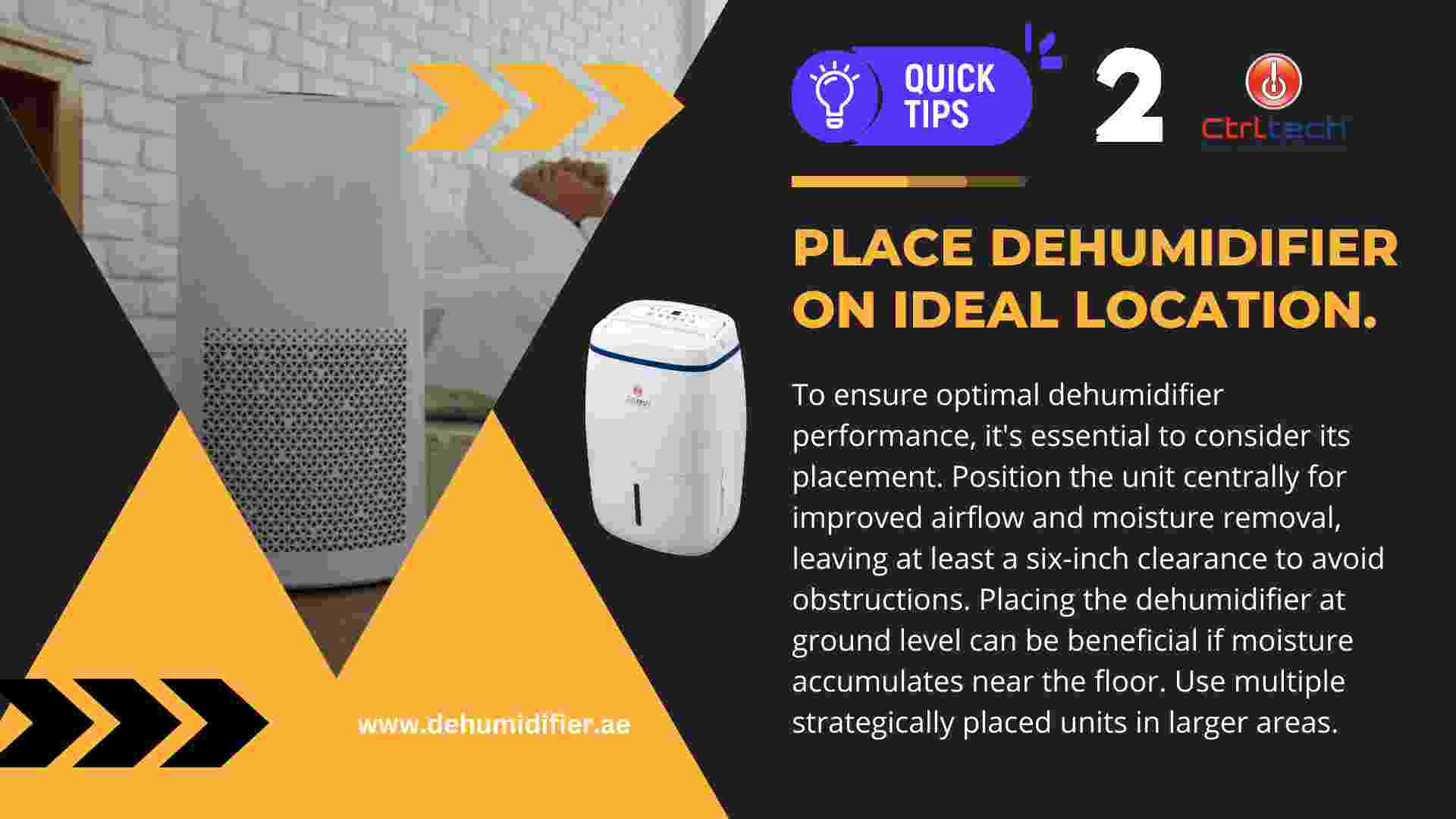
To ensure the optimal performance of your dehumidifier, consider the following when determining its placement:
Tip 3: Setting the Optimal Humidity Level.
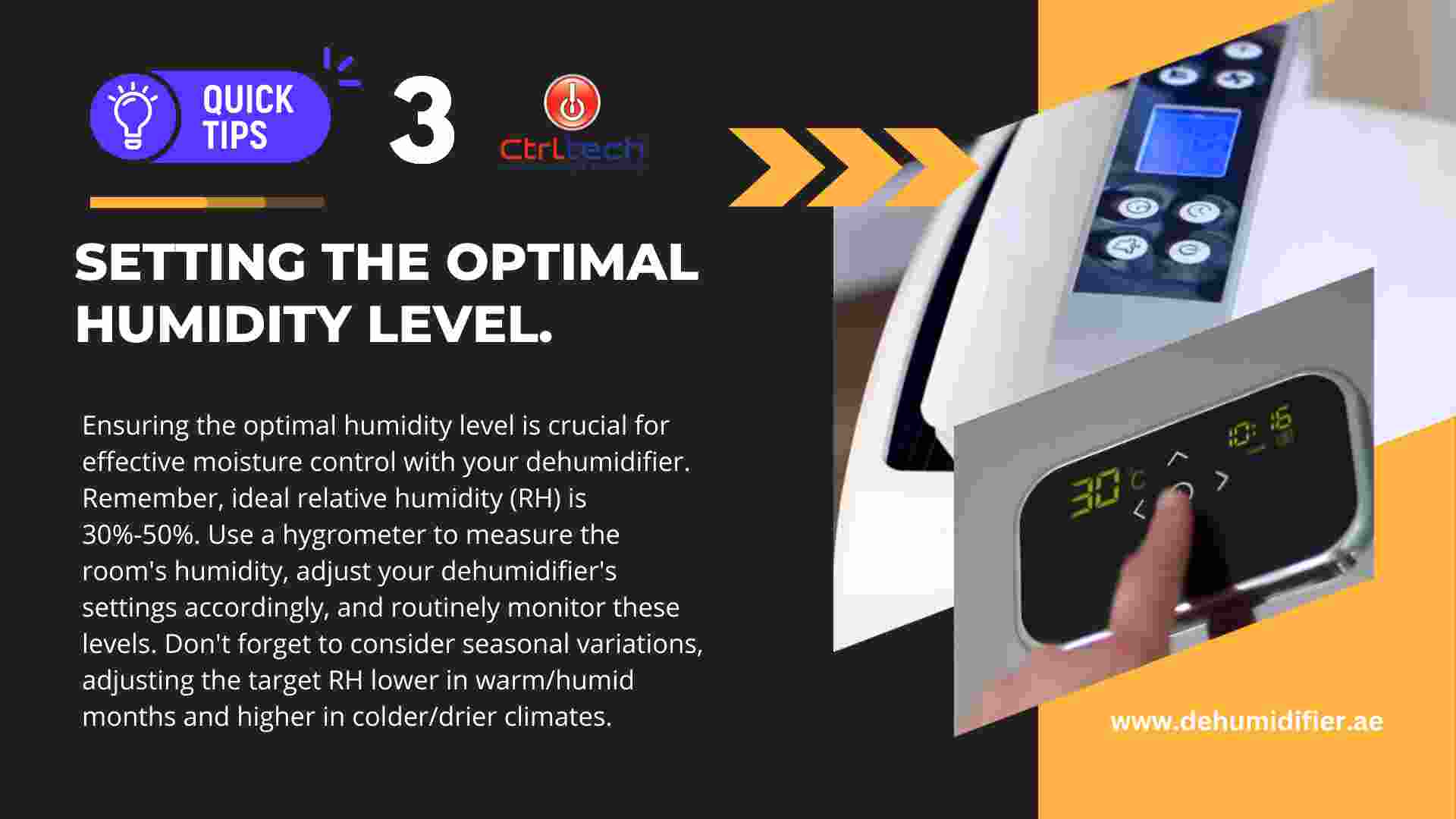
Setting the optimal humidity level is crucial to ensure your room dehumidifier effectively controls moisture and creates a comfortable living environment. Follow these steps to determine and select the appropriate humidity level.
Assessing Recommended Humidity Range: Most homes' ideal relative humidity (RH) level is between 30% and 50%. This range helps prevent mold growth, dust mites, and other moisture-related issues while maintaining a comfortable atmosphere...
Using a Hygrometer: You can buy a humidity meter from any hardware or electronic shop. Also, many models have it as a built-in feature. The digital version can give you accurate reading about the current room humidity. Measure humidity at the place where you are going to place the unit.
Adjusting the Humidity Settings: Most dehumidifiers allow you to adjust the target RH level using controls or digital settings. Aim for a level between 30% and 50% based on your comfort preferences and the specific requirements of your living space.
Observing the Hygrometer Readings: You must keep track of humidity reading to ensure you achieve the desired level. Adjust the settings if necessary to achieve optimal moisture control and comfort balance.
Considering Seasonal Changes: Note that humidity levels may vary with the seasons. During warmer months or in humid climates, you may need to set the dehumidifier to a lower target RH level to combat higher moisture levels. Conversely, you may increase the target RH level in colder months or drier climates to avoid overly dry conditions.
Adjust the dehumidifier settings to maintain the desired humidity level, considering seasonal variations and individual comfort preferences.
Read more
Tip 4: Regular Maintenance and Cleaning.
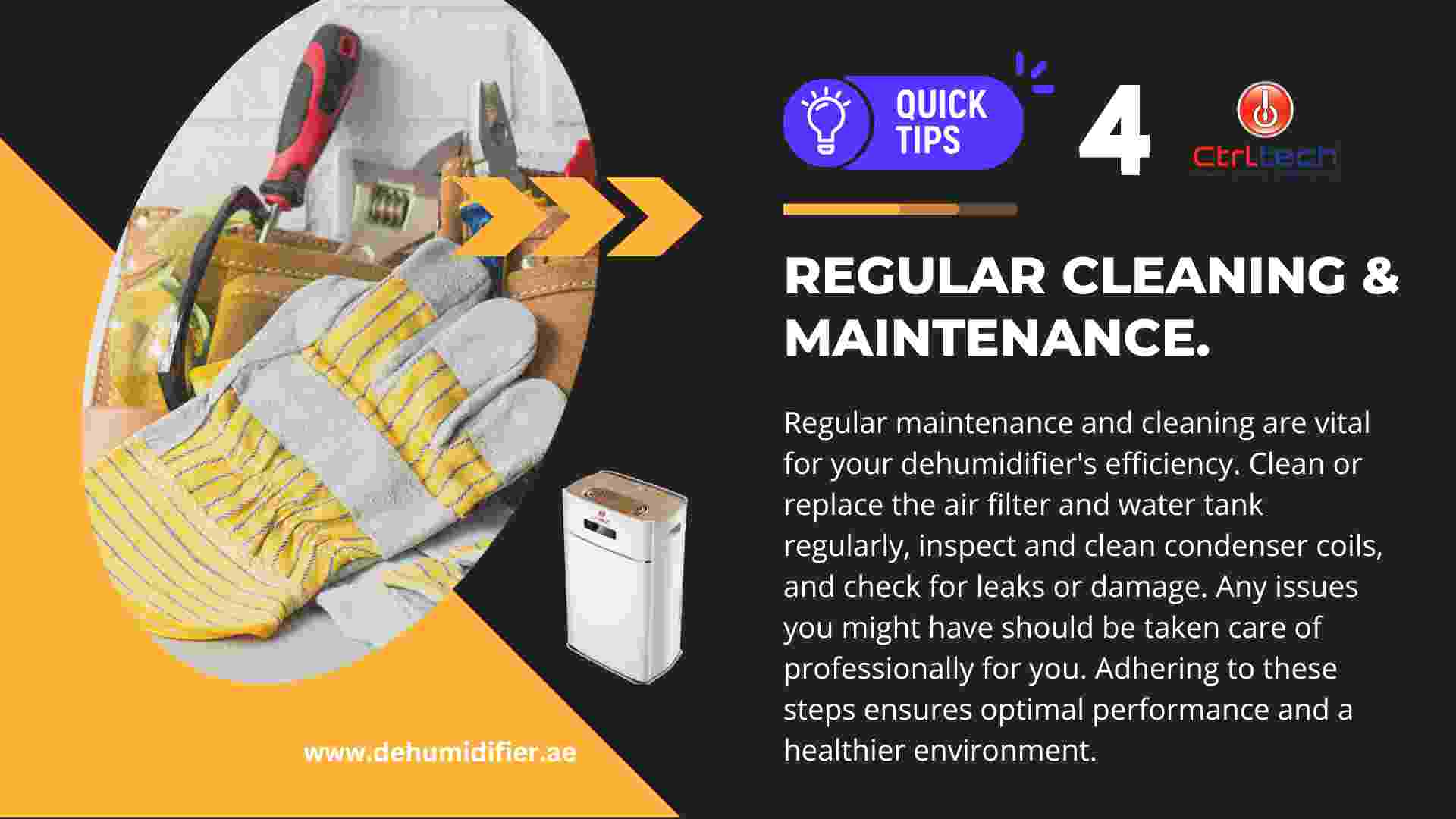
Regular maintenance and cleaning are crucial to keep your dehumidifier running efficiently. Follow these steps:
Clean or replace the air filter regularly to ensure proper airflow...
Empty the water tank as needed to prevent overflow.
Clean the water tank to remove buildup and residue.
Inspect and clean the condenser coils to optimize performance.
Check for leaks or damage and seek professional assistance if needed.
If you notice any issues, contact a professional or the manufacturer for repair or guidance.
Following these maintenance steps, you can keep your dehumidifier operating at its best, ensuring efficient moisture control and prolonging its lifespan.
Regular cleaning and care optimize its performance and promote a healthier living environment.
We have a detailed page on dehumidifier maintenance. Kindly refer to it to understand the servicing process in detail.
Read more
Tip 5: Ensure proper ventilation.
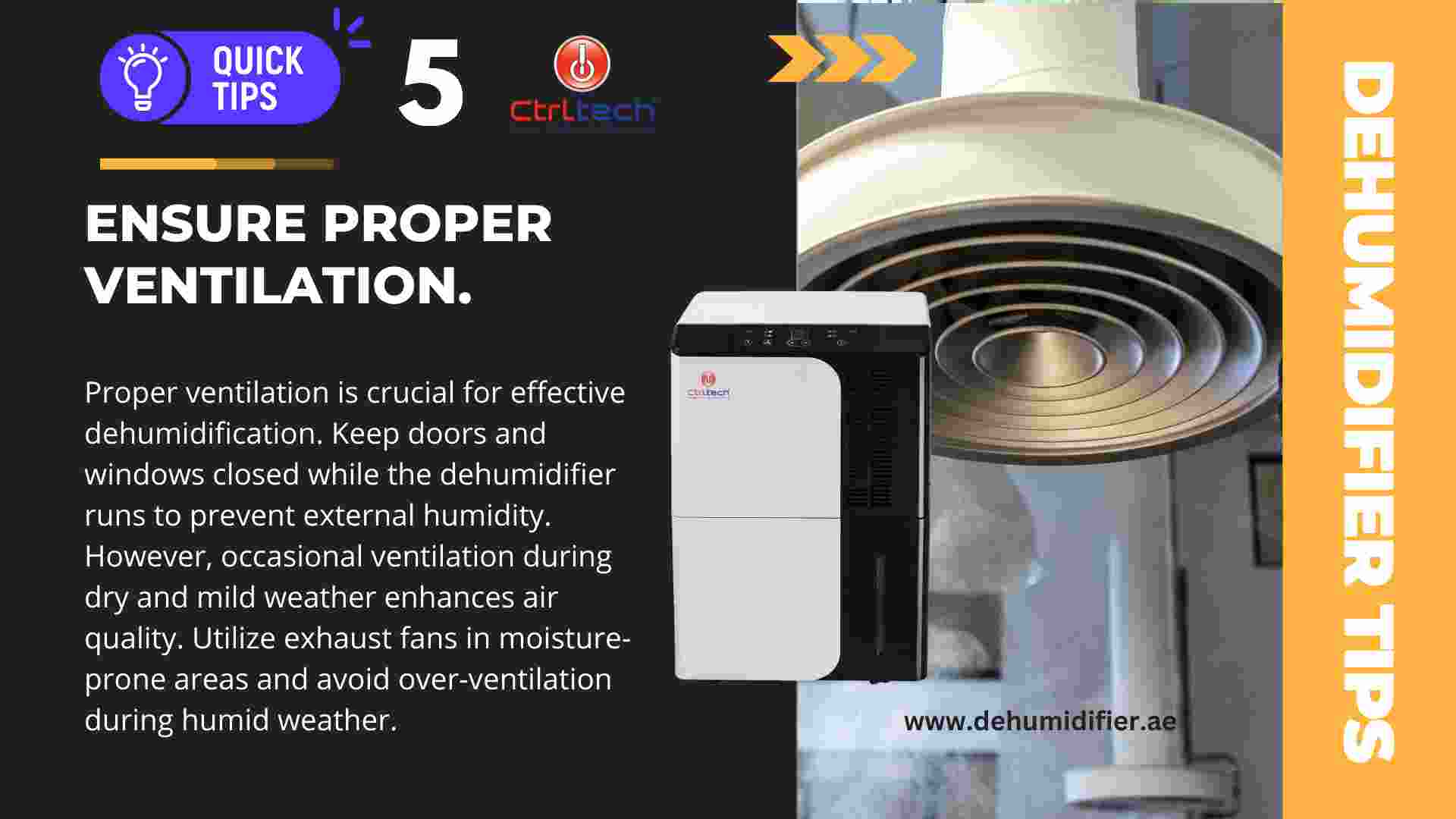
Dehumidifier performance and effectiveness depend on proper ventilation. Follow these tips for optimal ventilation:
Closed Doors and Windows: When running your dehumidifier, keep doors and windows closed to prevent additional humidity from entering the room. It allows the industrial dehumidifier to focus on extracting moisture from the existing air...
Occasional Ventilation: Periodically open doors and windows, especially during dry and mild weather conditions, to let fresh air circulate throughout your home. It helps improve overall air quality and reduces the buildup of stale air.
Utilize Exhaust Fans: In moisture-prone areas, such as bathrooms and kitchens, use exhaust fans. These fans remove excess humidity directly at the source, helping to prevent moisture-related issues.
Avoid Over-Ventilation: Even though ventilation is crucial, ventilating during humid weather is not recommended. It can introduce excessive moisture into your home and hinder the dehumidifier's effectiveness.
Proper Airflow: Ensure that furniture and objects are not blocking the airflow around the dehumidification system. Obstructions can impede adequate air circulation and reduce the commercial dehumidifier's performance.
Balancing proper ventilation with the dehumidifier's operation helps control moisture levels effectively and prevents the buildup of stagnant air.
Read more
Tip 6: Use a Dehumidifier with Other Appliances.
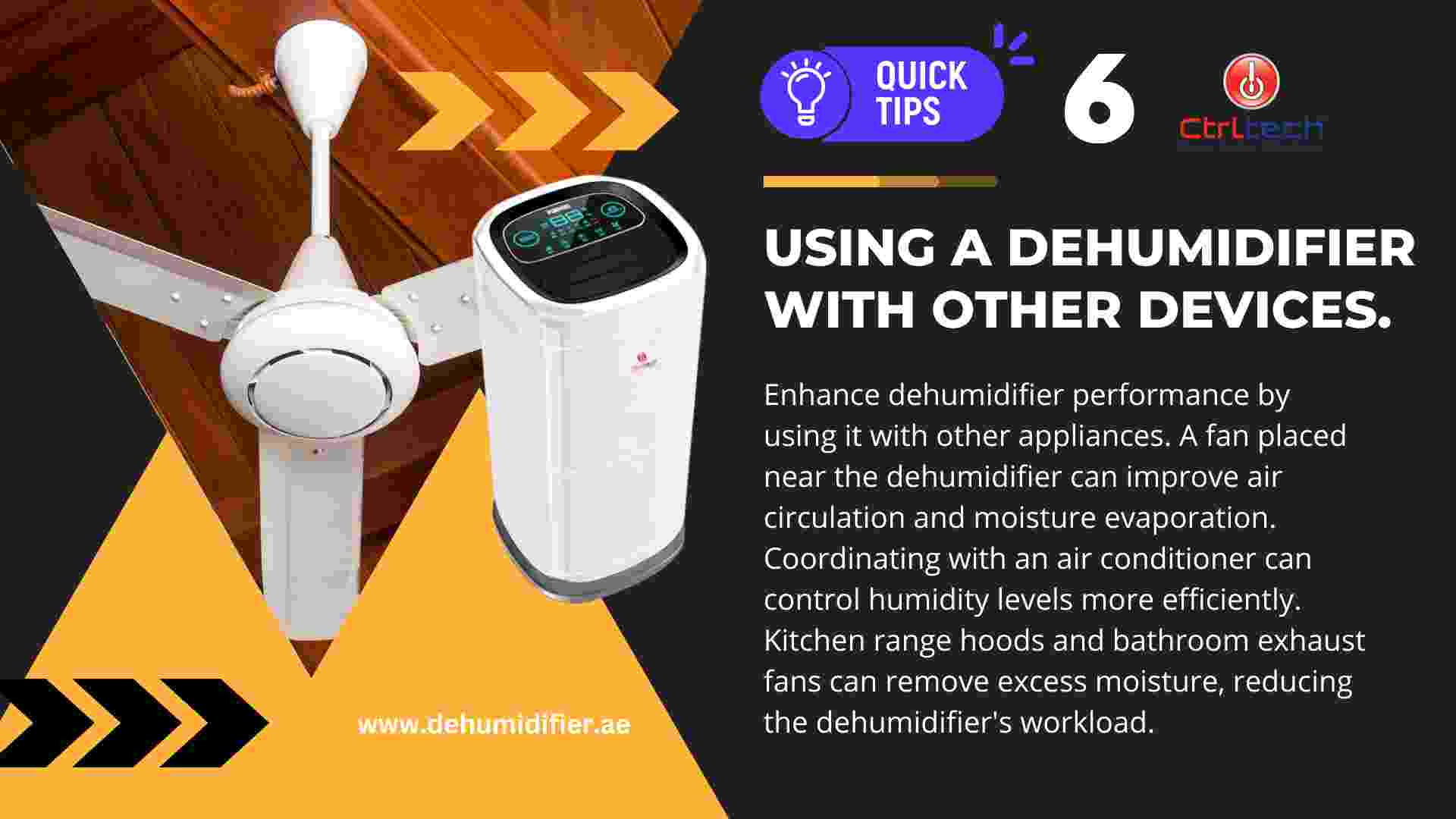
Using your unit, especially an industrial dehumidifier, in conjunction with other appliances can enhance its performance and contribute to better moisture control. Consider the following tips for maximizing the effectiveness of your dehumidifier when used with other devices:
Read more
Tip 7: Maximizing Energy Efficiency.

You can protect the environment by buying a unit that consumes low power and gives maximum output. Also, it will reduce electricity costs. Consider the tips given below while purchasing the system...
Choose an Energy-Efficient Model: Look for a certified Energy Star rating unit. ENERGY STAR dehumidifiers can significantly reduce your energy consumption compared to non-certified models. These models are designed to consume less energy while providing effective moisture control.
Right-Sizing the Dehumidifier: Always choose the suitable capacity dehumidification system to dehumidify your room area. An overcapacity dehumidifier will consume more energy than necessary, while an undersized one may struggle to maintain desired humidity levels. Refer to manufacturer guidelines or seek professional advice to determine the suitable capacity for your needs.
Utilize Timer Functions: Take advantage of the timer functions available on many dehumidifiers. Set the dehumidifier to run during off-peak hours or when you anticipate higher humidity levels. It helps avoid unnecessary energy consumption and reduces overall operating costs.
Seal Air Leaks: Ensure the room or area you are dehumidifying is adequately sealed. Seal any air leaks around windows, doors, or other openings to prevent moisture infiltration and reduce the workload on the dehumidifier. It allows for more efficient moisture control and energy usage.
Focus on Targeted Areas: If you only need to dehumidify specific areas of your home, close off unused rooms or areas. By focusing the dehumidification efforts where they are most needed, you can save energy by reducing the dehumidified square footage.
Choosing an energy-efficient model, right-sizing the dehumidifier, utilizing timer functions, sealing air leaks, and focusing on targeted areas are all steps toward creating an environmentally conscious and cost-effective home moisture control approach.
Read more
Tip 8: Additional tips for specific areas.
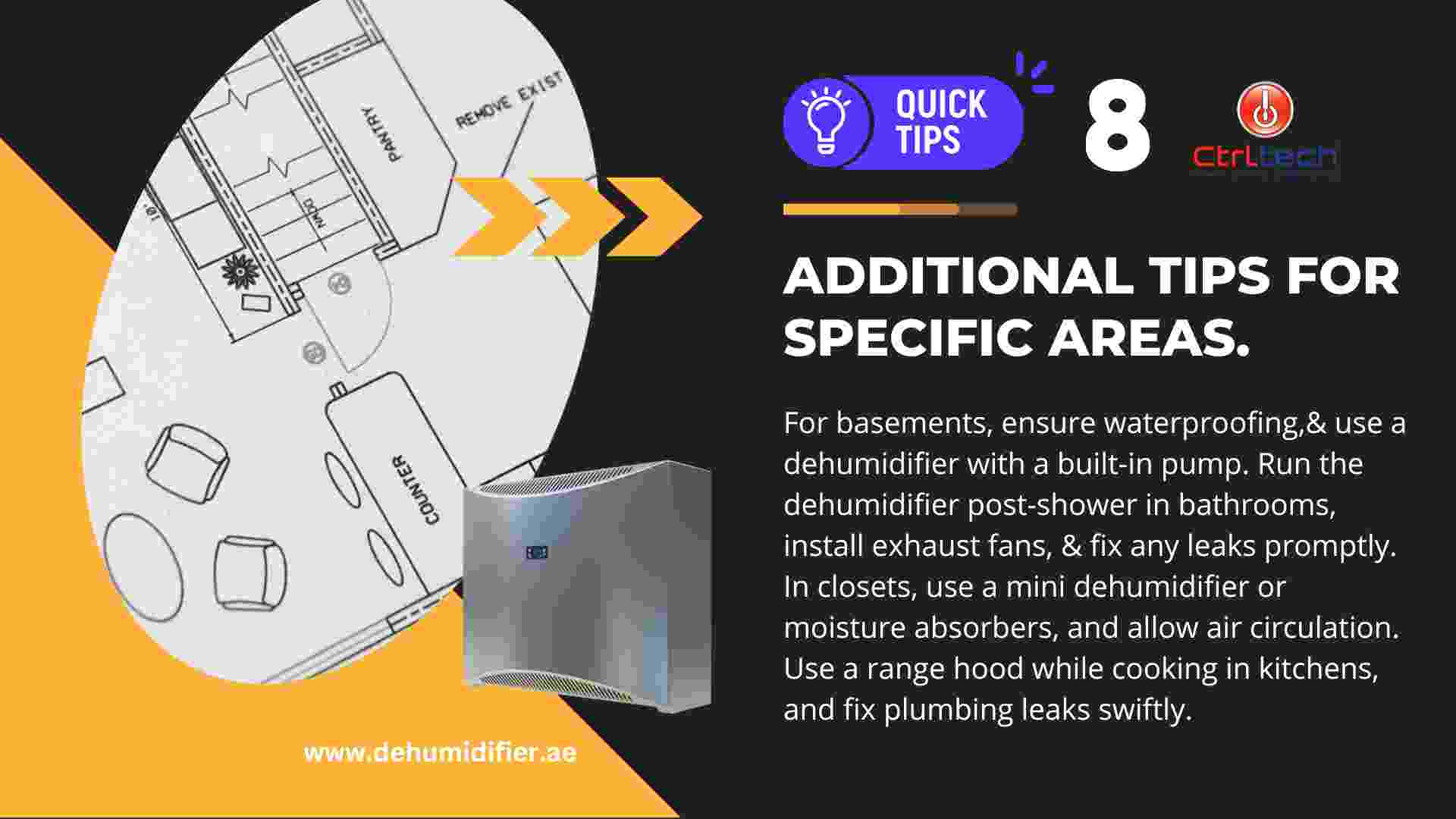
Different areas of your home may have specific moisture issues. Here are a few additional tips to address particular areas:
- Basement:
Ensure proper waterproofing to prevent excessive moisture from seeping in.
Consider using a basement dehumidifier with a built-in pump for continuous drainage.
Place the dehumidifier near the floor to target dampness at its source.
...
- Bathroom:
Use the dehumidifier after showers to eliminate excess humidity.
Install exhaust fans or improve ventilation to prevent moisture buildup.
drainage.Regularly check for and repair any leaks or plumbing issues.
- Closet:
Use a mini dehumidifier or moisture absorbers to control humidity levels.
Allow proper air circulation by leaving closet doors slightly open.
Avoid storing damp items that can contribute to moisture buildup.
- Kitchen:
Use a range hood while cooking to reduce moisture and odors.
Fix any plumbing leaks promptly to prevent water accumulation.
Wipe down countertops and surfaces to eliminate excess moisture.
By applying these additional dehumidifier tips, you can address specific moisture concerns in different areas of your home. Whether it's the basement, bathroom, closet, or kitchen, implementing targeted strategies alongside your dehumidifier helps create a more balanced and comfortable living environment.
Read more
Summary.
In conclusion, effectively managing moisture in your home requires careful consideration and utilization of your dehumidifier. By implementing the tips in this article, you can maximize the performance and efficiency of your dehumidifier, ultimately creating a comfortable living environment.
Firstly, We need to select the suitable capacity of the dehumidifier based on the space and desired humidity level. For living spaces, optimal humidity is 45 to 55% RH.
Hence, we should set the hygrometer to the same value. Finding the ideal location for your dehumidifier, such as a central position with no obstructions, ensures optimal airflow and moisture extraction.
Regular maintenance and cleaning prolong the lifespan of your dehumidifier and maintain its efficiency. Proper ventilation, achieved by keeping doors and windows closed while the dehumidifier is running and utilizing exhaust fans in moisture-prone areas, aids in controlling humidity levels.
Integrating your dehumidifier with other appliances, such as fans, air conditioners, kitchen range hoods, and bathroom exhaust fans, enhances its performance.
Finally, maximizing energy efficiency by choosing an energy-efficient model, right-sizing the dehumidifier, utilizing timer functions, sealing air leaks, and focusing on specific areas help reduce energy consumption.
By following these tips, we can get maximum benefits from dehumidifiers. Regular monitoring and maintenance of your dehumidifier will ensure continued effectiveness and a pleasant indoor atmosphere for you and your family.












